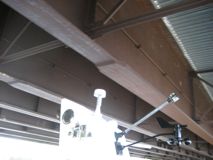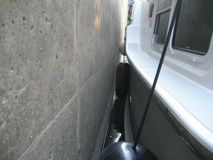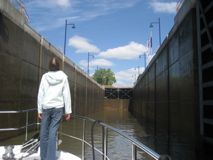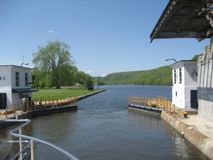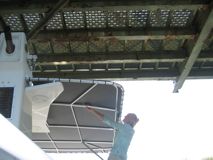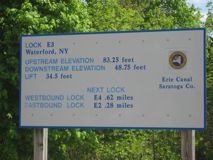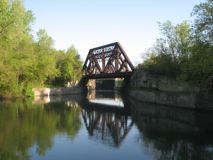Publish Date: Thursday, May 14, 2009
Location: Sylvan Beach, New York
Coordinates: 43° 11.765′ N 75° 43.641′ W
….Low bridge ’cause we’re coming to a town,
And you always know your neighbor,
You always know your pal,
If you’ve ever navigated on the Erie Canal.”
Do any of your remember that song? At first, Ayla would roll her eyes when Dave and I started singing this song, but now we have her singing right along with us. 🙂 And believe me, we sing it at least 10 times a day during this portion of our cruise. Did you know the song was written in 1913 to protest the mechanization of the Canal?
We have truly enjoyed our transit of the Erie Canal. We have had spectacular weather these last three days, with robin’s egg blue skies and billowy clouds. The waterway is filled with Canada Geese goslings, twittering birds building nests, and people riding their bikes, hiking, and fishing along the Erie Canal trails.
The locks are engineering wonders, with the lock masters being ambassadors of good will. Each lock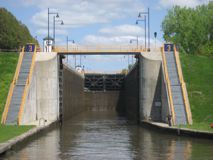 has its own personality:
has its own personality:
- Some walls are made of rock, others concrete, and still others are iron.
- Some locks lift you a few feet, while others lift you between 20 and 40 feet.
- Some locks are located next to large damns, roadways, railways, and towns, while others are tucked way in pure wilderness.
Locking through each one presents its own mini adventure.
For those you, who have not had the opportunity to “lock through” before, here is the quick process:
- Call the lock master and let him (so far, we haven’t met any female ones) know you’d like to lock
through. He will prepare the water level in the lock, open the lock doors, and give you the green light when you can enter.
- Make sure you have plenty of fenders dispersed at proper intervals along the side of your boat that will be next to the wall.
- Put Ayla out on the bow to smile and wave at the lock master — just in case we do anything stupid, they may take pity on us because at least we are friendly.
- Dave handles the piloting; Ayla and I handle the lock lines. The first few locks we used our own line and looped it to a cable mid-ship. The other locks had lines hung down the walls which we just held onto at the bow and stern.
- Once secured to the wall, the lock master closes the door behind you and begins to adjust the water level in the lock. 20 out of our 22 locks we were going up, only the last 2 were we going down.
- When you are going up, generally the water is filling from the side of both walls, creating a bit of a swirling motion that pushes the boat into the wall. Hence the need for good fenders to protect the boat, and good line handlers to help keep the boat from moving around in the lock. This is particularly important when locking through with a number of other boats.
- There is a tingly sense of anticipation as you wait at the bottom of a lock. You are in a big hole;
then gradually you begin to move upward, wondering what awaits you at the top; finally you are rewarded with a peek over the side — seeing a park, a dam, a town, a tug boat or a variety of other things.
- Once the water is at the correct level, the doors open, and Dave gives the command to drop our lines, and we are off down the next section of waterway; offering plenty of waves and thanks to our lock master.
Often there are locals who come out to watch the boats locking through their town, and there is always time for a brief chat about our destination, or local points of interest. Each lock takes ~20 minutes, depending on the lift. Although the process can be a little stressful due to maneuvering, the whole experience is very intimate.
When we are not busy going through a lock, we are carefully watching the bridge heights. There are lots
of bridges across the canal, and unlike the ICW, these are fixed bridges — you either fit under them or you don’t. On the eastern section of the canal (which is the part we just completed) the bridge clearances are at least ~21ft. However, there can be as much as a foot of variation depending on rain, and other run off into the canal. With all of our antennas down and everything else we can take down, our clearance is 20 feet 4 inches. When a bridge looks particularly close, Dave’s slows to a near stop, I take a walkie-talkie and climb up on the side of our flybridge. I can then tell him what our clearance looks like and which way to go. We only had one bridge that was a bit too close for comfort, grazing the rivets of the I-beam. Whew! All others we had at least 6 inches or more. 🙂
We have been incredibly fortunate to experience this part of our country’s history. I had learned about it in school, but I never truly understood the engineering accomplishment, or its profound significance in the expansion of our country (connecting the inland waters of the Great Lakes with the Atlantic Ocean). A few quick facts, and then I promise I’ll stop:
- Original canal opened in 1825
- Waterford Flight of locks has the highest lift in the shortest distance of any locks in the world (twice the lift of the Panama Canal)
- 57 locks, with lift from 6 feet to 40.5 feet
- 306 bridges cross the canal
- New York Canal system is almost 800 miles long, ten times longer than the Panama Canal
In case, you couldn’t tell, I think cruising the Erie Canal rocks!!!
